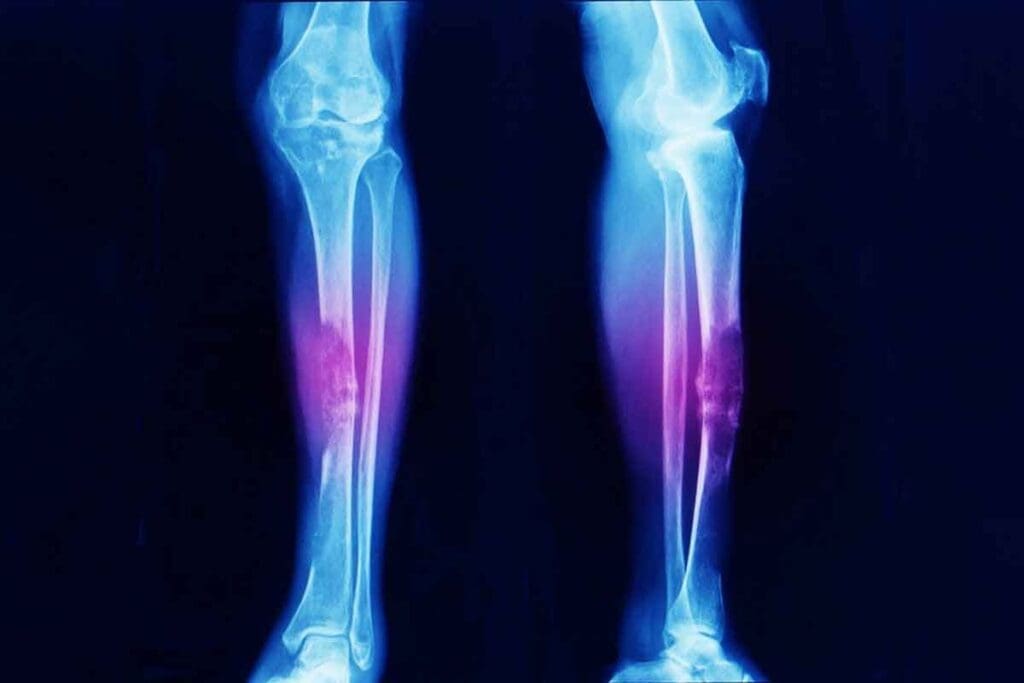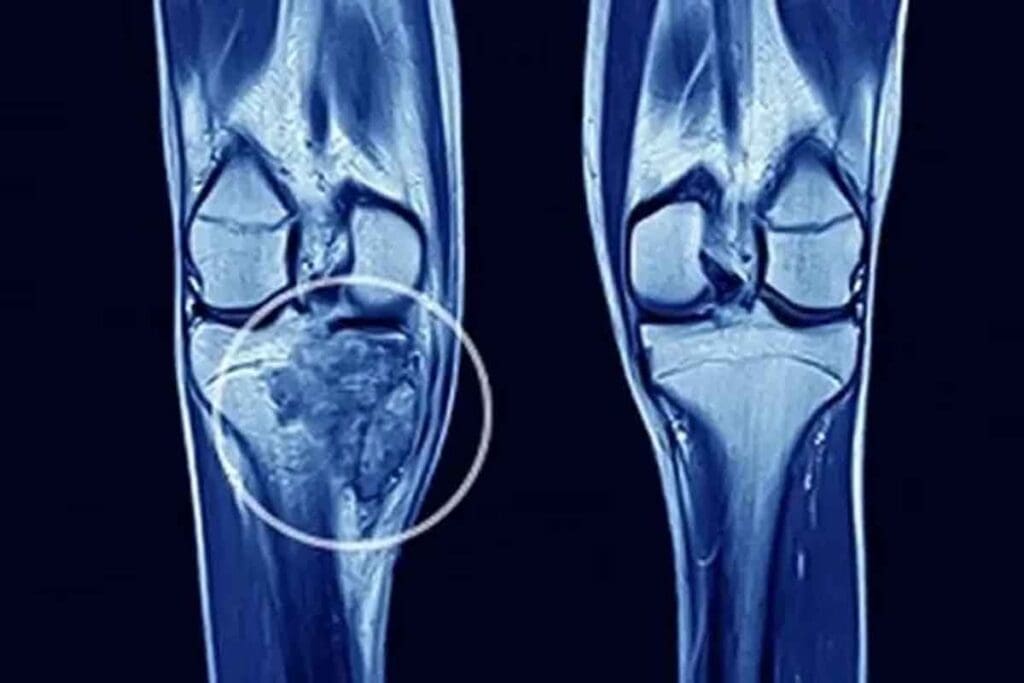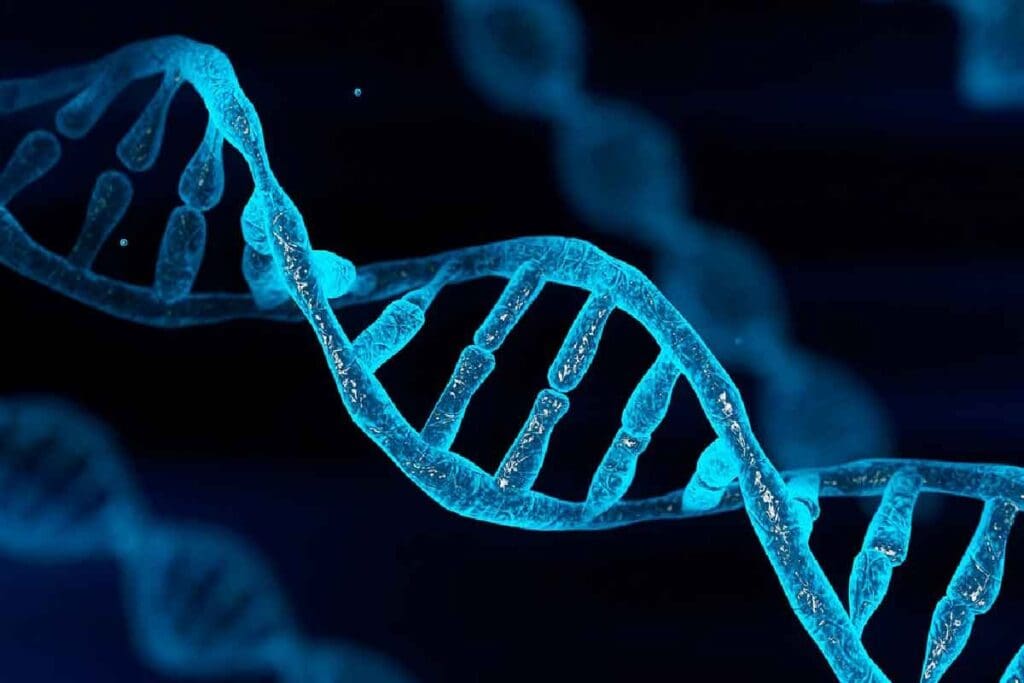Last Updated on November 20, 2025 by Ugurkan Demir

Ewing sarcoma is a rare and aggressive cancer that mostly hits kids and teens. It causes tumors in bones or soft tissue. Quick diagnosis and effective treatment are key.
At Liv Hospital, we know how vital early detection and full care are for Ewing sarcoma patients. Our team uses a team approach. This means patients get the newest treatments and lots of support.
It’s important to understand Ewing’s sarcoma to know its causes, symptoms, and treatment options. We give you the latest info from top medical sources.

Ewing Sarcoma is a rare cancer that affects bones or the soft tissue around them. It is most common in teenagers and young adults.
Ewing Sarcoma is a part of the Ewing’s family of tumors (EFT). This includes Ewing’s Sarcoma of bone, extraosseous Ewing’s Sarcoma, and primitive neuroectodermal tumors (PNET). These cancers have a specific genetic change, leading to an EWS-FLI1 fusion gene in most cases.
Understanding the types of Ewing Sarcoma is key. Accurate diagnosis is vital for the right treatment plan.
James Ewing first described Ewing Sarcoma in 1921. He was an American pathologist who identified this unique tumor. The term “Ewing Sarcoma” has been used ever after.
Our understanding of Ewing Sarcoma has grown over time. Advances in genetics and molecular pathology have helped clarify its characteristics.
Ewing Sarcoma is a rare disease, making up about 1% of all childhood cancers. It is most common in people aged 10 to 20, with more males affected. The disease is more common in North America and Europe than elsewhere.
Knowing the epidemiology of Ewing Sarcoma helps find risk factors and causes. This information can guide treatments and prevention strategies.

Ewing Sarcoma is driven by EWSR1 gene translocations. These genetic changes are key to understanding the disease’s growth and spread.
The EWSR1 gene is central to Ewing Sarcoma. Translocations involving this gene create fusion proteins that fuel tumor growth. The most common is t(11;22)(q24;q12), making the EWS-FLI1 fusion gene.
Key aspects of EWSR1 gene translocations include:
Ewing Sarcoma’s molecular pathogenesis is complex. It involves genetic and epigenetic factors. The EWS-FLI1 fusion protein changes gene expression, leading to cancer.
Ewing Sarcoma is unique compared to other bone cancers like osteosarcoma. Its genetic and molecular traits are different. A key difference is the EWSR1 gene translocations in Ewing Sarcoma.
| Characteristics | Ewing Sarcoma | Osteosarcoma |
| Genetic Hallmark | EWSR1 gene translocations | Complex karyotypic abnormalities |
| Common Age Group | Children and young adults | Adolescents and young adults |
| Primary Locations | Long bones, pelvis, and chest wall | Long bones, mainly around the knee |
Knowing these differences is vital for correct diagnosis and treatment. By identifying Ewing Sarcoma’s unique genetic and molecular traits, doctors can tailor treatments.
Knowing the risk factors and demographics of Ewing sarcoma is key for early detection and treatment. We’ll look at age and gender, racial and ethnic patterns, and environmental and developmental factors.
Ewing sarcoma can happen at any age but is most common in kids and young adults. It peaks in the teenage years, with more males than females getting it.
A study in the Journal of Clinical Oncology found the median age at diagnosis is about 15. Males are more likely to get it, with a ratio of about 1.4:1.
| Age Group | Incidence Rate |
| 0-14 years | 3.4 per million |
| 15-19 years | 4.6 per million |
| 20-24 years | 2.1 per million |
Ewing sarcoma shows different patterns in different races and ethnicities. It’s more common in Europeans and less common in Africans and East Asians. This might hint at a genetic link.
“The incidence of Ewing sarcoma varies significantly across different ethnic groups, with the highest rates observed in non-Hispanic whites and the lowest in individuals of African descent.” –
Source: National Cancer Institute
The exact causes of Ewing sarcoma are not known. But, radiation and genetics might be risk factors.
In summary, knowing the demographics and risk factors of Ewing sarcoma is essential for better diagnosis and treatment. More research is needed to improve patient care.
Knowing where Ewing sarcoma often starts and spreads is key for early treatment. It can happen in any bone or soft tissue. But, some places are more common.
Ewing sarcoma usually happens in long bones like the thigh, shin, and upper arm bones. It also often affects the pelvis and ribs. These are where the disease usually begins.
The disease tends to favor areas with lots of cell activity and growth. Here’s a table showing common bone sites for Ewing sarcoma:
| Primary Bone Site | Frequency |
| Pelvis | Common |
| Long bones (femur, tibia, humerus) | Very Common |
| Ribs | Common |
| Vertebral column | Less Common |
Ewing sarcoma is mostly known as a bone cancer. But, it can also start in soft tissues around bones or in other body parts. Soft tissue Ewing sarcoma is less common but has similar features.
It can show up in the chest, abdomen, arms, or other areas. Doctors use imaging and biopsies to diagnose it.
Ewing sarcoma can spread to other parts of the body. It often goes to the lungs, other bones, and bone marrow. Knowing how it spreads helps doctors plan treatment.
Metastatic Patterns:
Understanding these patterns helps doctors create a detailed treatment plan. This includes treatments like chemotherapy.
Spotting Ewing Sarcoma symptoms early is key to better treatment results. We’ll cover the common signs and symptoms to watch for.
Pain is usually the first sign of Ewing Sarcoma. This pain can be constant and get worse, focusing on the tumor area. It might hurt more at night or when you’re active.
As the disease grows, swelling or a noticeable mass may appear near the tumor. This swelling can be sore and get bigger with time.
Some people with Ewing Sarcoma also have body-wide symptoms. These include fever, weight loss, and tiredness. These signs show the cancer is affecting the body more widely.
If you’re feeling ongoing pain, swelling, or other Ewing Sarcoma symptoms, get medical help right away. Early treatment can greatly improve your chances of recovery.
It’s vital to know these symptoms and signs. This way, you can get medical help quickly and get the right treatment.
To find out if you have Ewing sarcoma, we use many tests. These tests help us see how big the disease is and where it is. Knowing this helps us plan the best treatment for you.
First, we take a detailed look at your medical history and do a physical check-up. We check for signs like pain, swelling, and trouble moving. These signs might mean there’s a tumor.
Imaging tests are key in finding Ewing sarcoma. We use X-rays, CT scans, MRI scans, and PET scans. These tests tell us about the tumor’s size, where it is, and if it has spread.
A biopsy is very important to confirm Ewing sarcoma. We take tissue samples with a needle or surgery. Then, a pathologist checks the samples.
Molecular testing is also very important. We look for certain genetic changes, like the EWSR1-FLI1 fusion gene. This helps us make sure it’s Ewing sarcoma and not another cancer.
| Diagnostic Method | Purpose |
| Medical History and Physical Examination | Identify symptoms and signs of Ewing sarcoma |
| Imaging Tests (X-rays, CT, MRI, PET) | Determine tumor size, location, and possible spread |
| Biopsy | Confirm diagnosis through tissue examination |
| Molecular Testing | Find specific genetic changes linked to Ewing sarcoma |
Treating Ewing sarcoma needs a team effort. We’ll look at how different doctors work together. This teamwork is key to helping patients.
A team of doctors is essential for Ewing sarcoma care. This team includes oncologists, surgeons, and radiologists. They create a treatment plan for each patient.
This team approach helps manage care better. It leads to improved patient outcomes. It’s all about teamwork for the best results.
Chemotherapy is a big part of Ewing sarcoma treatment. Neoadjuvant chemotherapy shrinks the tumor before surgery. Adjuvant chemotherapy kills any cancer cells left after treatment.
The treatment uses a mix of drugs. The exact drugs and doses depend on the patient’s health and disease stage.
| Chemotherapy Agent | Mechanism of Action | Common Side Effects |
| Vincristine | Mitotic inhibitor | Neuropathy, constipation |
| Doxorubicin | Anthracycline antibiotic | Cardiotoxicity, alopecia |
| Cyclophosphamide | Alkylating agent | Hemorrhagic cystitis, myelosuppression |
Surgery is used with chemotherapy and radiation to treat Ewing sarcoma. The goal is to remove the tumor and affected tissue. The surgery type depends on the tumor’s location and size.
New surgical methods aim to save limbs. This can improve a patient’s quality of life and function.
Radiation therapy is used for Ewing sarcoma, mainly when surgery is hard or the cancer has spread. It can be used alone or with other treatments.
It’s used for tumors that can’t be removed, leftover disease after surgery, or cancer that has spread. The method used depends on the tumor’s location and size.
New radiation therapy methods are more precise. They reduce side effects and improve results for patients.
Ewing sarcoma’s outlook depends on several factors like the stage and where it is found. Knowing these details is key for patients and their families. It helps them face the challenges of diagnosis and treatment.
Thanks to better treatments, survival rates for Ewing sarcoma have gone up. For those with localized Ewing sarcoma, the five-year survival rate is about 70 percent. But, for those with metastatic disease, it’s between 15 percent and 30 percent.
| Disease Stage | Five-Year Survival Rate |
| Localized | 70% |
| Metastatic | 15-30% |
Several factors affect how well Ewing sarcoma patients do. These include:
Keeping an eye on patients long-term is key to catch any signs of recurrence or treatment side effects. Regular check-ups with a healthcare provider are vital. They help keep an eye on the patient’s health and quickly address any issues.
Survivors of Ewing sarcoma need to think about their quality of life. Treatment side effects, like heart problems or secondary cancers, can affect long-term health. So, ongoing care and support are essential to keep quality of life high.
Dealing with Ewing sarcoma is tough, but with the right help and support, patients and their families can get through it. Our aim is to offer complete care and guidance during treatment and beyond.
Understanding Ewing sarcoma is key to catching it early and treating it well. We’ve looked into what Ewing sarcoma is, its genetic roots, and how EWSR1 gene changes play a big role. We’ve also talked about risk factors, where it often shows up, and its symptoms, stressing the need for quick medical help.
New ways to diagnose Ewing sarcoma have made finding it more accurate. Treatment now involves a team effort, using chemotherapy, surgery, and radiation. It’s important to see how well patients are cared for to measure treatment success.
Research keeps pushing forward, bringing hope for better treatments and lives for those with Ewing sarcoma. We must keep looking for new ways to fight this tough cancer.
Ewing sarcoma is a rare and aggressive cancer. It mainly affects kids and teens. It can happen in bones or soft tissue.
Symptoms include pain, swelling, and a mass. You might also feel feverish and lose weight.
Doctors use imaging, biopsies, and molecular tests. They look for the EWSR1 gene translocation.
Treatment involves a team effort. It includes chemotherapy, surgery, and radiation therapy.
Prognosis depends on the disease’s stage and location. Survival rates are better for localized cases.
Risk factors include age and genetics. Most cases happen in kids and teens.
Ewing sarcoma has a specific gene translocation. It affects younger patients. Osteosarcoma is more common in older kids and adults.
Genetic testing confirms Ewing sarcoma by finding the EWSR1 gene translocation.
Many patients with localized Ewing sarcoma can be cured. Treatment outcomes vary.
Treatment can cause late effects. These include chemotherapy, radiation, and surgery side effects. Ongoing care is important.
No, Ewing sarcoma is not contagious. It cannot spread from person to person.
Research aims to improve treatment and understand the disease. It focuses on developing targeted therapies.
Subscribe to our e-newsletter to stay informed about the latest innovations in the world of health and exclusive offers!